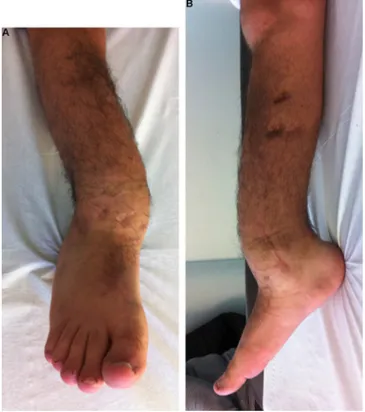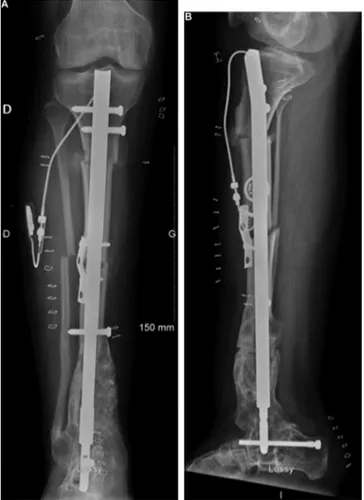O
pen
A
rchive
T
oulouse
A
rchive
O
uverte
(OATAO)
OATAO is an open access repository that collects the work of some Toulouse
researchers and makes it freely available over the web where possible.
This is
an author's
version published in: https://oatao.univ-toulouse.fr/23116
Official URL :
https://doi.org/10.1016/j.otsr.2017.10.012
To cite this version :
Any correspondence concerning this service should be sent to the repository administrator:
tech-oatao@listes-diff.inp-toulouse.fr
Pollon, Tristan and Sales de Gauzy, Jérôme and Pham, Thuy Trang and Thevenin Lemoine,
Camille and Accadbled, Franck Salvage of congenital pseudarthrosis of the tibia by the
induced membrane technique followed by a motorised lengthening nail. (2018) Orthopaedics &
Traumatology: Surgery & Research, 104 (1). 147-153. ISSN 1877-0568
OATAO
Case report
Salvage of congenital pseudarthrosis of the tibia by the induced
membrane technique followed by a motorised lengthening nail
T. Pollon
∗, J. Sales de Gauzy , T. Pham , C. Thévenin Lemoine , F. Accadbled
Département de chirurgie orthopédique, traumatologique et plastique, CHU de Toulouse, place du Dr-Baylac, 31059 Toulouse, France
Keywords:
Limb length discrepancy Congenital pseudarthrosis Fitbone®
Masquelet technique Induced membrane technique Tibia
Neurofibromatosis
a b s t r a c t
An 18-year-old male with neurofibromatosis type I was treated for congenital pseudarthrosis of the tibia using the Masquelet induced-membrane technique with internal fixation by retrograde implantation of a transplantar intramedullary nail. Bone healing was obtained at the expense of malunion with external rotation and 5.5 cm of lower limb shortening. A motorised intramedullary-lengthening nail (Fitbone®, Wittenstein, Igersheim, Germany) was implanted. This treatment was successful in correcting the rota-tional malalignment and limb length discrepancy. The motorised nail Fitbone®may be a valid option for treating complex cases of limb length discrepancy, including those combined with limb deformities.
1. Introduction
Congenital pseudarthrosis of the tibia (CPT) is a bone abnor-mality that is strongly associated with neurofibromatosis type 1
(NF1). The prevalence of CPT is 1/190,000[1]. Two major
therapeu-tic challenges must be met to achieve good outcomes: bone healing must be obtained, and the alignment abnormalities must be cor-rected. The technical difficulties in achieving these goals increase with patient age.
2. Case report
This 18-year-old male with NF1 presented with CPT manifes-ting as congenital bowing of the right leg. The deformity persisted despite two previous treatment attempts using the Ilizarov device followed by a third surgical procedure for shortening and inter-nal fixation of the tibia. At referral to our centre, the right lower limb was 5 cm shorter than the left, and the deformity combined
40◦of fixed flexion, 10◦of valgus, and anterior bowing of the tibial
shaft (Figs. 1 and 2). Range of motion was normal at the knee and
restricted at the ankle.
∗ Corresponding author.
Treatment was with the induced membrane technique using
gentamicin-loaded Palacos® bone cement (Zimmer Biomet,
War-saw, IN, USA), realignment of the leg, and internal fixation via the
transplantar retrograde implantation of a T2®tibial nail (Stryker,
Kalamazoo, MI, USA), after resection down to bone devoid of
macro-scopic dystrophy (Fig. 3). The second stage was performed 6 weeks
later and involved implanting autologous cancellous bone
har-vested from the two iliac crests (Fig. 4).
The outcome was favourable, with evidence of bone healing after 3 months. However, a leg length discrepancy of 5 cm persisted,
and the leg was in 40◦of external rotation (Fig. 5).
Bone lengthening was therefore performed by implantation of
a motorised intramedullary nail (Fitbone®, Wittenstein, Igersheim,
Germany) 2 years after the induced membrane procedure. In addi-tion, the rotational malalignment was corrected. Thus, two tibial osteotomies were performed, one at the metaphysis to allow bone lengthening and the other at the midpoint of the diaphysis to imme-diately restore rotational alignment. The motorised nail bridged
the ankle joint (Fig. 6). The intramedullary canal was patent, and
no approach of the pseudarthrosis site was required. The limb was lengthened by 3 cm over 60 days. The presence after 4 months of
15◦of valgus and 30◦of flexion in the lengthening callus required
revision surgery for implantation of a locked nail (Fig. 7). The
val-gus deformity was corrected by implantation of a conventional intramedullary-locking nail (Stryker). The proximal poly-axial
locked nailing optimized the stability of the construct (Fig. 8).
Fig. 1. Clinical appearance.
Fig. 3. First stage of reconstruction using the induced membrane technique, with implantation of cement, partial realignment in the coronal and sagittal planes, and
transplantar implantation of a locking nail.
Fig. 4. Second stage of reconstruction using the induced membrane technique, with insertion of autologous cancellous bone grafts harvested from both posterior iliac crests.
The internal fixation material was removed 2 years after the last surgical procedure. Bone healing and limb realignment were
obtained (Figs. 9 and 10). Tibial slope was 26◦and the residual limb
length discrepancy was 2 cm. Range of motion was normal at the
knee. At the ankle, the arc of motion was 15◦.
3. Discussion
In patients with CPT, nailing combined with the external fix-ation using the Ilizarov device has also been reported to provide
good outcomes[2]. Zhu et al. obtained good bone healing rates
Fig. 5. Lower limb telemetry showed 5.5 cm shortening of the right leg and malunion with 40◦of external rotation. Note the evidence of bone healing.
Fig. 6. Postoperative radiographs after distraction osteotomies and rotational realignment via a motorised nail.
with the two-stage Ilizarov technique [3]. Bone healing was
achieved in 2 patients treated by Muhammad et al. using ream-ing, realignment, nailream-ing, and lengthening in an Ilizarov device,
without resection of the pseudarthrosis site [4]. Cho TJ et al.
suggested proximal metaphyseal dysplasia as a risk factor for
treatment failure [5]. Vascularised bone grafts have also
pro-duced good outcomes [6,7]. Accadbled et al. showed that the
motorised nail Fitbone® method based on callus distraction
(cal-lotasis) after osteotomy was effective in correcting limb length
discrepancies[8].
In our patient, transplantar nailing and implantation of a cement
cav-Fig. 7. Radiographs taken 4 months after implantation of the motorised nail, showing a small callus at the proximal metaphysis and a deformity with 30◦of flexion and 15◦ of valgus; note the cut-out of a proximal locking nail.
ity [10]. The arthroereisis of the tibio-talar and sub-talar joints
improved the stability of the construct[11] but contributed to
restrict the mobility of these joints[12].
The second stage of deformity correction was not performed at the CPT site, as this strategy is associated with a high risk of non-union. Although performing two osteotomies can impair the blood
supply to the intermediate fragment[13], this option was chosen
for its greater technical simplicity.
The risk of displacement causing flexion deformity during limb lengthening seems greater when the osteotomy is located more proximally. The nail is probably unable to effectively control this risk.
Fig. 8. Postoperative radiographs after revision surgery for realignment using an intramedullary-locking nail; the valgus is fully corrected but the flexion deformity shows
little change.
Fig. 10. Radiograph obtained 2 years after the last surgical procedure; bone healing is complete, and the tibial slope is 26◦.
4. Conclusion
The Masquelet technique ensured bone healing but left
resid-ual deformities. Implantation of a motorised Fitbone® corrected
the limb length discrepancy, and healing of the tibia was obtained despite the CPT and two osteotomies.
Disclosure of interest
The authors declare that they have no competing interest.
References
[1]Hefti F, Bollini G, Dungl P, Fixsen J, Grill F, Ippolito E, et al. Congenital pseu-darthrosis of the tibia: history, etiology, classification, and epidemiologic data. J Pediatr Orthop 2000;9:11–5.
[2]Agashe MV, Song S-H, Refai MA, Park K-W, Song H-R. Congenital pseu-darthrosis of the tibia treated with a combination of Ilizarov’s technique and intramedullary rodding. Acta Orthop 2012;83:515–22.
[3]Zhu G, Mei H, He R, Liu K, Tang J, Wu J. Effect of distraction osteogenesis in patient with tibial shortening after initial union of congenital pseu-darthrosis of the tibia: A preliminary study. BMC Musculoskelet Disord 2015; 16:216.
[4]Muhammad Abdul Jamil MK, Abdul Rashid AH, Ibrahim S. Congenital pseudoarthrosis of the tibia: healing by lengthening over a rod without
compression of the nonunion. A preliminary report. J Pediatr Orthop 2013;22: 207–12.
[5]Cho T-J, Choi IH, Lee KS, Lee SM, Chung CY, Yoo WJ, et al. Proximal tibial length-ening by distraction osteogenesis in congenital pseudarthrosis of the tibia. J Pediatr Orthop 2007;27:915–20.
[6]Coleman SS, Coleman DA. Congenital pseudarthrosis of the tibia: treatment by transfer of the ipsilateral fibula with vascular pedicle. J Pediatr Orthop 1994;14:156–60.
[7]Tan JS, Roach JW, Wang AA. Transfer of ipsilateral fibula on vascular pedi-cle for treatment of congenital pseudarthrosis of the tibia. J Pediatr Orthop 2011;31:72–8.
[8]Accadbled F, Pailhé R, Cavaignac E, Sales de Gauzy J. Bone lengthening using the Fitbone®motorized intramedullary nail: the first experience in France. Orthop Traumatol Surg Res 2016;102:217–22.
[9]Black SR, Kwon MS, Cherkashin AM, Samchukov ML, Birch JG, Jo C-H. Lengthen-ing in congenital femoral deficiency: a comparison of circular external fixation and a motorized intramedullary nail. J Bone Joint Surg Am 2015;97:1432–40.
[10]Shah H, Doddabasappa SN, Joseph B. Congenital pseudarthrosis of the tibia treated with intramedullary rodding and cortical bone grafting: a follow-up study at skeletal maturity. J Pediatr Orthop 2011;31:79–88.
[11]Chalopin A, Pesenti S, Peltier E, Bin K, Launay F, Jouve J-L. Transplantar intramedullary locking nailing in childhood congenital pseudarthrosis of the tibia: a report of 3 cases. Orthop Traumatol Surg Res 2016;102:521–4.
[12]Seo SG, Lee DY, Kim YS, Yoo WJ, Cho T-J, Choi IH. Foot and ankle function at maturity after Ilizarov treatment for atrophic-type congenital pseudarthrosis of the tibia: a comprehensive outcome comparison with normal controls. J Bone Joint Surg Am 2016;98:490–8.
[13]Shirai H, Abe M, Nagaoka T, Onomura T. Appropriate osteotomy site and number in limb lengthening. Clin Orthop Related Res 1997;336:308–17.





